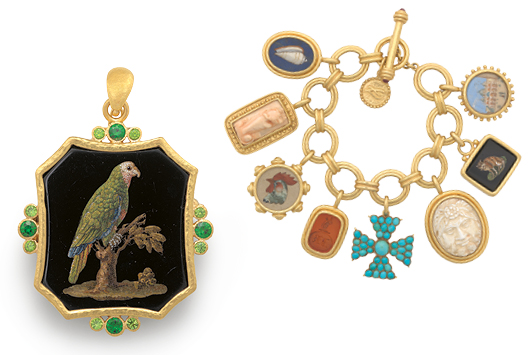
An impressive array of micromosaics on display at the Virginia Museum of Fine Arts (VMFA) offers a close-up of how talented 18th- and 19th-century artists used tiny glass “bricks” known as tesserae to create portraits, the same way a painter uses different hues of paint on a canvas.
The pieces make up the exhibition “A Return to the Grand Tour: Micromosaic Jewels from the Collection of Elizabeth Locke.” Locke, a contemporary jewelry designer, “has been acquiring micromosaics for almost 30 years,” explains Dr. Susan J. Rawles, VMFA associate curator of American painting and decorative art. The exhibit “is a representative sampling of more than 90 works produced during the late 18th and 19th centuries. While [Locke] retains a few pieces in their original box or setting, most of the works have been reset into her own designs, which are themselves inspired by ancient materials and techniques.”
Micromosaics were a must-have purchase for “Grand Tour” travelers — young, upper-class Europeans taking their traditional coming-of-age trip around the continent. These jewels had a twofold appeal, explains Rawles. On the one hand, the intricacies of their creation made them novelties. “The ingenuity involved in crafting micromosaics — creating tens of thousands of shades of glass, mastering the technique of pulling the glass into thin threads, and then cutting and placing the glass in such a way as to mimic the brushstrokes of miniature painting — must certainly have appealed to those generations of enlightened collectors captivated by the marriage of art and industry,” she notes.
On the other hand, they were also private and personal mementos of travels that could be worn as adornments or shared among friends, she continues. “These characteristics have charmed collectors since the 18th century, when micromosaic works were kept as souvenirs, gifted to others, or taken to a local goldsmith to be set as a brooch, pendant or other form of jewelry.”
The interest in micromosaics was also part of a fascination with ancient jewelry and the Archeological Revival style following excavations at Etruscan sites in the early 1800s, adds Rawles.
Star attractions
The jewels on display represent major thematic categories, including religious, mythological and antique subjects, Grand Tour sites, animals, landscapes and pastoral scenes. The earliest subject matter of micromosaics was religious in nature, inspired by Renaissance paintings in the Vatican, Rawles points out. Once the market for micromosaics was established, the scope of subjects expanded to include popular tourist spots, such as the Roman Forum or the Pantheon.
“The era’s interest in science and entomology led to additional subjects,” she says, “as did bespoke commissions for favorite pets. The interest in landscapes and gardening followed. All these themes...would have found favor among contemporary patrons according to their taste.”
The late-18th-century works attributed to Giacomo Raffaelli (1753-1836) — including an extraordinary box of 20 micromosaic butterflies that closes into a book — demonstrate the technique and Enlightenment-inspired themes of some early works, explains Rawles. “The wonderful portrait of a horse in a landscape may be unique, and the delightful image of the seated poodle in its original box is a favorite. [Locke] is drawn to works of high quality and appealing subject rather than provenance.”
Collector’s choice
Marked examples from the 18th century are highly collectible, but it is their condition and workmanship that is prized.
“Quality is measured by the number of pieces of glass per square inch, the successful use of color, nuances of tone, and the condition of the piece, as well as its subject and maker,” says Rawles. “While micromosaics were produced intermittently in various urban studios, most works in the exhibition are thought to have been made in Rome.”
With the advent of the internet, the days of stumbling upon a beautiful micromosaic at an art fair or auction have all but passed, and prices continue to rise, observes Rawles.
“Careful examination of these diminutive works requires patience and a good loupe,” she adds. “Cracks in the glass, added fill and clumsy execution reduce the value of works. The best examples are tightly rendered, nuanced in tone and without damage. An original label or box is a bonus.”
Image: Virginia Museum of Fine Arts; Collection of Elizabeth Locke.Article from the Rapaport Magazine - May 2019. To subscribe click here.